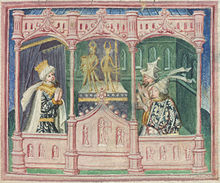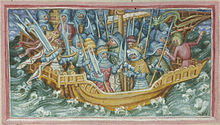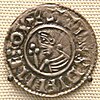Ivar the Boneless
This article needs attention from an expert in history. The specific problem is: style; does not read like an encyclopedia article. (February 2018) |

Ivar the Boneless (Old Norse: Ívarr hinn Beinlausi [ˈiːˌwɑrː ˈhinː ˈbɛinˌlɔuse]; born in 800s[citation needed]–c. 873), also known as Ivar Ragnarsson, was a Viking leader who invaded England. According to the Tale of Ragnar Lodbrok, he was the son of Ragnar Loðbrok and his wife Aslaug. His brothers included Björn Ironside, Halfdan Ragnarsson, Hvitserk, Sigurd Snake-in-the-Eye and Ubba.
The origin of the Nickname is not certain. "Ívarr beinlausi" could be translated to "Ivar legless", but "beinlausi" could also be translated as "boneless", since "bone" and "leg" translates to the same word, "bein", in Old Norse.[2] Several of the sagas describe him as lacking legs/bones, while a passage in Ragnarssona þáttr (also known as the tale of Ragnar's sons) suggest it refers to male impotence.[3]
According to the Tale of Ragnar Lodbrok, Ivar's bonelessness was the result of a curse. His mother, Aslaug, was Ragnar's third wife. She was described as a völva, a type of seer or clairvoyant. She said that she and her husband must wait three nights before consummating their marriage after his return following a long separation (while he was in England raiding). However, Ragnar was overcome with lust after such a long separation and did not heed her words. As a result, Ivar was born with weak bones.[4]
Another hypothesis is that he was actually known as "the Hated", which in Latin would be Exosus. A medieval scribe with only a basic knowledge of Latin could easily have interpreted it as ex (without) os (bone), thus "the Boneless",[5] although it is hard to align this theory with the direct translation of his name given in Norse sources.[4]
While the sagas describe Ivar's physical disability, they also emphasise his wisdom, cunning, and mastery of strategy and tactics in battle.[6]
He is often considered identical to Ímar, the founder of the Uí Ímair dynasty, which at various times, from the mid-ninth to the tenth century, ruled Northumbria from the city of York, and dominated the Irish Sea region as the Kingdom of Dublin.[7]
Chronology[]



- 865 the Great Heathen Army, led by Ivar, invaded the Anglo-Saxon Heptarchy.[8] The Heptarchy was the collective name for the seven kingdoms East Anglia, Essex, Kent, Mercia, Northumbria, Sussex and Wessex. The invasion was organised by the sons of Ragnar Lodbrok, to wreak revenge against Ælla of Northumbria who had supposedly executed Ragnar in 865 by throwing him in a snake pit, but the historicity of this explanation is unknown.[9][10] According to the saga, Ivar did not overcome Ælla and sought reconciliation. He asked for only as much land as he could cover with an ox's hide and swore never to wage war against Ælla. Then Ivar cut the ox's hide into such fine strands that he could envelop a large fortress (in an older saga it was York and according to a younger saga it was London), which he could take as his own. (Compare the similar legendary ploy of Dido.)
- Late the next year, the army turned north and invaded Northumbria, eventually capturing Ælla at York in 867.[11] According to legend, Ælla was executed by Ivar and his brothers using the blood eagle, a ritual method of execution of debated historicity whereby the ribcage is opened from behind and the lungs are pulled out, forming a wing-like shape.[7] Later in the year, the Army moved south and invaded the kingdom of Mercia, capturing the town of Nottingham, where they spent the winter. King Burgred of Mercia responded by allying with the West Saxon king Æthelred of Wessex, and with a combined force they laid siege to the town. The Anglo-Saxons were unable to recapture the city, but a truce was agreed whereby the Danes would withdraw to York.[11] The Great Heathen Army remained in York for over a year, gathering its strength for further assaults.[11]
- Ivar and Ubba are identified as the commanders of the Danes when they returned to East Anglia in 869, and as the executioners of the East Anglian king, Edmund the Martyr, for refusing their demand that he renounce Christ.[12] The precise account of Edmund's death is unknown, however it has been suggested that his capture and execution at the hands of the sons of Ragnar is likely to have occurred.[13]
Death[]
The Anglo-Saxon chronicler Æthelweard records his death as 870.[14] The Annals of Ulster describe the death of Ívar in 873. The death of Ívar is also recorded in the Fragmentary Annals of Ireland under the year 873.[15]
The identification of the king of Laithlind as Gothfraid (i.e., Ímar's father) was added by a copyist in the 17th century. In the original 11th-century manuscript, the subject of the entry was simply called righ Lochlann ("the king of Lochlainn"), which more than likely referred to Ímar, whose death is not otherwise noted in the Fragmentary Annals. The cause of death—a sudden and horrible disease—is not mentioned in any other source, but it raises the possibility that the true origin of Ivar's Old Norse nickname lay in the crippling effects of an unidentified disease that struck him down at the end of his life.
In 1686, a farm labourer named Thomas Walker discovered a Scandinavian burial mound at Repton in Derbyshire close to a battle site where the Great Heathen Army overthrew the Mercian King Burgred of his kingdom. The number of partial skeletons surrounding the body—over 250—signified that the man buried there was of very high status. It has been suggested that such a burial mound is possibly the last resting place of Ivar.[16]
According to the saga, Ivar ordered that he be buried in a place that was exposed to attack, and prophesied that, if that was done, foes coming to the land would be met with ill-success. This prophecy held true, says the saga, until "when Vilhjalm bastard (William I of England) came ashore[,] he went [to the burial site] and broke Ivar's mound and saw that [Ivar's] body had not decayed. Then Vilhjalm had a large pyre made upon which Ivar's body was] burned... Thereupon, [Vilhjalm proceeded with the landing invasion and achieved] the victory."[17][18]
Fictional portrayals[]
- Ivar the Boneless is a minor character in the 1969 film Alfred the Great,[19] portrayed as an acrobatic and agile warrior.
- In the 2013 film Hammer of the Gods, Ivar the Boneless is portrayed as a reclusive, homosexual viking. (The character was played by Ivan Kaye, who later portrayed King Aelle in the History Channel's TV series Vikings.[20])
- In the History Channel's 2013 TV series Vikings, Ivar is portrayed as the son of Ragnar and Aslaug and a younger half-brother to Björn Ironside. He first appeared in Season Two as a baby, and later was played by James Quinn Markey and Alex Høgh Andersen.[21]
- Ivar's invasion of East Anglia and killing of Edmund the Martyr are depicted in the video for The Darkness's song Barbarian.[22]
- Ivar is a significant character, alongside his brother Ubba in Bernard Cornwell's Saxon Stories novel series, including the first The Last Kingdom (2004). Throughout the subsequent television adaptation by the same name, however, Ivar remains an unseen character.
- Ivar the Boneless and his brothers Ubba and Halfdan, all appear in the video game, Assassin's Creed: Valhalla as allies of the main protagonist, Eivor. Here he is portrayed as extremely aggressive and callous, causing friction with the other characters. Ivar is voiced by Canadian actor, Eric Johnson.
References[]
- ^ Hervey, Francis (1907). Corolla Sancti Eadmundi = The garland of Saint Edmund, king and martyr. London: John Murray. OL 11080612W.
- ^ "Leg in Danish". dictionary.cambridge.org. Retrieved 5 February 2021.
- ^ Groeneveld, Emma (12 November 2018). "Ivar the Boneless". World History Encyclopedia.
- ^ Jump up to: a b Baker, Mick. "Anglo-Saxon Britain: In the Footsteps of Ivarr the Boneless". The History Files. Retrieved 1 September 2016.
- ^ Ferguson, Robert (2009). The hammer and the cross: a new history of the Vikings. London: Allan Lane. ISBN 978-0713997880. OCLC 609990781.
- ^ Mahoney, Mike. "Ivar the Boneless". www.englishmonarchs.co.uk. Retrieved 14 April 2017.
- ^ Jump up to: a b Holman, Katherine (2007). The northern conquest: Vikings in Britain and Ireland. Oxford: Signal Books. ISBN 9781904955344. OCLC 166381361.
- ^ Venning, Timothy (19 June 2013). The Kings & Queens of Anglo-Saxon England. Amberley. ISBN 9781445608976.
- ^ Munch, Peter Andreas (10 September 2010). Olsen, Magnus (ed.). Norse Mythology: Legends Of Gods And Heroes. Kessinger Publishing, LLC. ISBN 9781164510307.
- ^ Jones, Gwyn (1 November 1984). A History of the Vikings (Revised ed.). Oxford University Press. ISBN 9780192158826.
- ^ Jump up to: a b c Forte, Angelo; Oram, Richard; Pedersen, Frederik (30 May 2005). Viking Empires (First ed.). Cambridge University Press. ISBN 9780521829922.
- ^ Swanton, Michael J., ed. (18 August 1998). The Anglo-Saxon Chronicle (First ed.). Routledge. ISBN 9780415921299.
- ^ Mostert, Marco (1 January 1987). The political theology of Abbo of Fleury: A study of the ideas about society and law of the tenth-century monastic reform movement. Verloren. ISBN 9789065502094.
- ^ Giles, J. A., ed. (10 September 2010). Six Old English Chronicles: Ethelwerd's Chronicle, Asser's Life Of Alfred, Geoffrey Of Monmouth's British History, Gildas, Nennius And Richard Of Cirencester. Kessinger Publishing, LLC. ISBN 9781163125991.
- ^ "Fragmentary Annals of Ireland 409". CELT. Retrieved 2 February 2009.
- ^ Arnold, Martin. The Vikings: A Short History by Martin Arnold. The History Press.
- ^ "Ivar the Boneless, Ragnar Lothbrok's Son - Mythologian.Net". mythologian.net. Retrieved 19 April 2017.
- ^ "Saga of Ivar (The Boneless) Ragnarsson | Up Helly Aa". www.uphellyaa.org. Retrieved 19 April 2017.
- ^ "Alfred the Great (1969) - Overview - TCM.com".
- ^ "Hammer of the Gods". 30 May 2013 – via IMDb.
- ^ Schwartz, Terri (21 April 2016). "Vikings: Meet the Four New Actors Revealed in Season 4's Midseason Finale". IGN. Retrieved 22 December 2016.
- ^ "The Darkness Return With 'Barbarian' Video: Exclusive Premiere". Billboard.com. Retrieved 2 June 2015.
- 873 deaths
- Monarchs of Jorvik
- Northumbrian monarchs
- 9th-century English monarchs
- Monarchs of Dublin
- Uí Ímair
- Viking warriors
- House of Munsö
